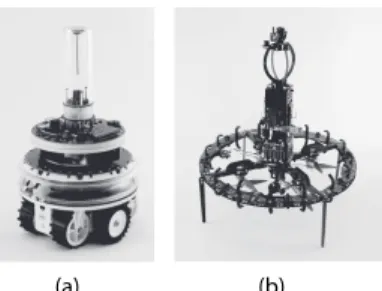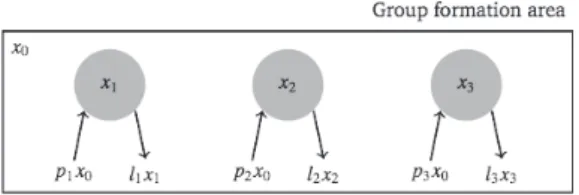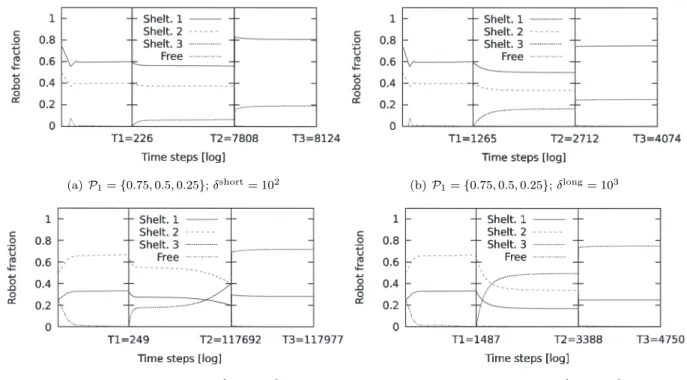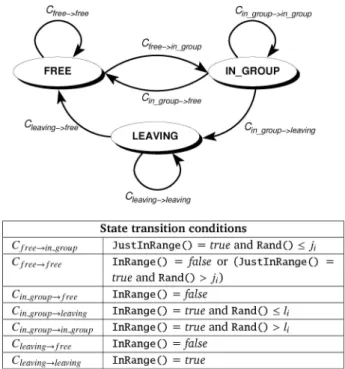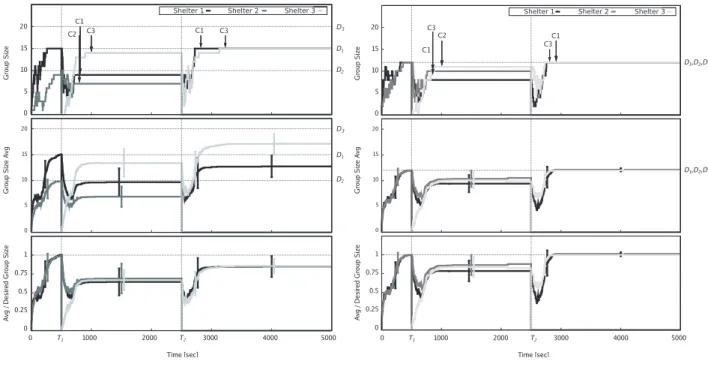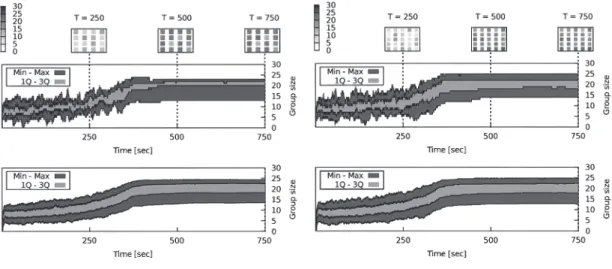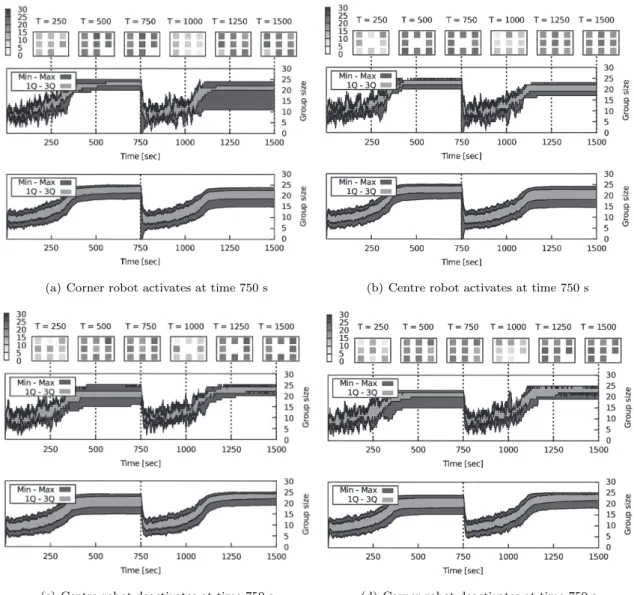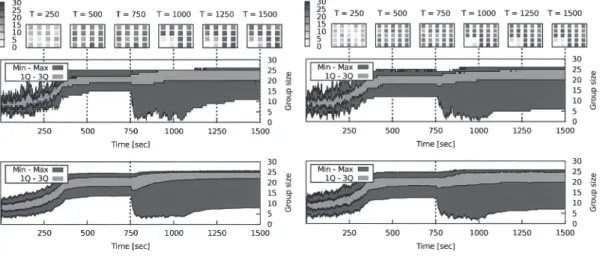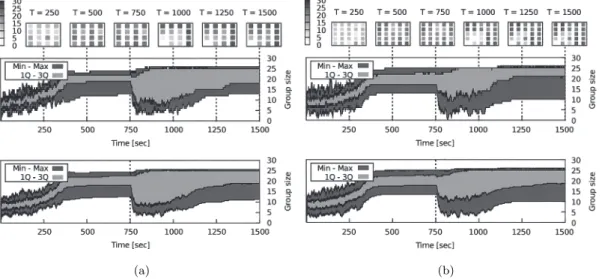Parallel Formation of Differently Sized Groups in a
Robotic Swarm
Carlo P
INCIROLI
*
・
Rehan O’G
RADY
*
・
Anders Lyhne C
HRISTENSEN
**
Mauro B
IRATTARI
*
・
Marco D
ORIGO
*
*IRIDIA, Universit´e Libre de Bruxelles, 50 Avenue F. Roosevelt, CP 194/6, 1050 Bruxelles, Belgium
**Instituto Universit´ario de Lisboa (ISCTE-IUL) & Instituto de Teleco-municac¸ ˜oes, Av. das Forc¸as Armadas, 1649–026, Lisbon, Portugal
*E-mail: cpinciro@ulb.ac.be, rogrady@ulb.ac.be, anders.christensen@ iscte.pt, mbiro@ulb.ac.be, mdorigo@ulb.ac.be
Key Words:swarm robotics, group formation
JL 0003/13/52030213 2013 SICEC
1
.
Introduction
Swarm robotics is a branch of collective robotics fo-cused on the study of relatively large groups of robots with limited sensing and communication capabilities. One of the main benefits of such systems is their poten-tial for parallelism. To achieve parallelism in real-world scenarios, it is important to be able to split the swarm into appropriately sized groups for different concurrent tasks.
Imagine a swarm of robots that must be deployed to monitor the spread of an environmental hazard. Differ-ent hazard areas of various sizes will need correspond-ingly sized groups of robots, and the hazard sites may be spread far apart. As in any such real-world scenario, it is likely that there will not be enough robots to allo-cate the ideal number to each hazard site. In this pa-per, we propose a distributed mechanism to solve this type of group formation problem, whereby large num-bers of robots must be divided into multiple groups in parallel. When the number of available robots is suf-ficient, our system is capable of forming groups of dif-ferent, pre-defined sizes. When the available robots are less than the sum of the desired sizes, our system dis-tributes robots fairly across groups, ensuring that each group grows at the same rate.
Existing approaches to parallel group formation in multi-robot systems have limitations that render them inappropriate for this type of scenario. Decentralised task allocation and task partitioning approaches scale well, but they only work when the tasks are located close to each other and the density of robots is suffi-ciently high7). Centralised approaches, on the other hand, can efficiently divide a population of robots into specific group sizes matching different tasks, but do not
scale to large swarms of robots due to high communi-cation overheads4). The only decentralised approaches that have tackled the formation of specific group sizes in swarms of robots have restricted themselves to forming or counting a single group of robots at a time3), 11).
Our work is inspired by the aggregation behaviour of cockroaches under shelters. The dynamics of this be-haviour are well understood, and predict different ag-gregated group sizes in an environment with different sized shelters. Am´e et al.1) modelled cockroaches as simple agents that walk randomly in an environment, and have a certain probability of stopping that increases with the presence of a shelter and with proximity to other stopped cockroaches. This model is a good fit for the parallel group size selection problem in robotics, as there is no communication required between agents. Our approach does not, therefore, suffer from the scal-ability limits of centralised approaches. We use ‘active shelters’, that can affect the probability of robots stop-ping underneath them within a certain communication range. By varying the stopping probabilities associated with different shelters, we reproduce the effect of differ-ent shelter sizes and create robotic groups of differdiffer-ent required sizes.
2
.
Related Work
In swarm robotics, existing approaches to the prob-lem of splitting up a swarm of robots into groups re-volve around distributed forms of task allocation7) — scalable, decentralised approaches with low or no com-munication overheads. In these approaches, individ-ual robots have a mechanism for testing the task and allocating themselves to different tasks or sub-tasks. Testing by robots can, for example, take the form of determining whether an object is moving in a group
transport scenario13), or testing the time taken to per-form a task or sub-task15). The performance (and/or convergence time) of these methods typically depends on the number of interactions among robots per time unit, which, in turn, depends on the density of robots in the environment. An ideal density range exists, in which these methods perform best. Below a certain den-sity threshold, the robots interact too rarely for these methods to be practically appliable. Above a certain threshold, the robots spend significant time avoiding each other rather than performing their assigned tasks. In real-world scenarios, the available robots are often scarce, tasks may be located far apart from one an-other, and explicit group sizes may need to be allocated based on some external (human) assessment of the prob-lem. Under these circumstances, task-allocation-based approaches may not be feasible.
Explicit group size formation has been demonstrated as feasible in the swarm robotics context, but only for a single group at a time. Melhuish et al.11) con-trolled group sizes in a swarm of abstract agents using a firefly-like synchronisation mechanism. However, only one group was formed at a time and the physics of the agents was not taken into account. Brambilla et al.3) used physically embodied robots, but their system could only passively count the number of robots in a single ex-isting group (rather than generating a group of a priori determined target size). Hsieh et al.9) have studied an abstraction of the problem we study, whereby robots must distribute across multiple sites in predefined ra-tios. Hsieh et al.’s work is based on statistical models of the house hunting behaviour of the ant Temnothorax albipennis.
In multi-robot systems formed by a low number of in-dividuals, market-based approaches provide a good so-lution to the problem of parallel group formation of ex-plicit group sizes4). Market-based approaches, however, have intrinsic scalability problems that render them less applicable to swarm robotics systems. In market-based approaches, all robots participate in an auction, and market forces determine the most appropriate alloca-tion of robots to groups corresponding to particular tasks. However, the fact that every robot must par-ticipate in the auction process means that bandwidth and computation requirements increase quickly with the number of robots.
Our approach is inspired by the aggregation be-haviour of cockroaches18). Cockroach behaviour is
ac-curately mimicked by Jeanson’s et al. model10)in which cockroaches stochastically switch from stopping to per-forming a random walk and back. The probability of stopping rather than random walking increases with the number of other nearby stopped cockroaches. A pos-itive feedback mechanism then results in aggregation into groups. When multiple shelters of different sizes are available in the environment, cockroaches may form groups of different sizes that correspond to the sizes of shelter available1).
Previous robotics studies have shown how cockroach behaviour can be faithfully mimicked by a group of robots. Existing robotic implementations share key fea-tures of the cockroach model. In particular, the equilib-rium distribution of agents depends passively on the ini-tial configuration of the environment and on the static mapping of environmental conditions to stop/go prob-abilities6). None of the existing studies, however, have used the model to generate a priori desired group sizes, or explored how many such groups could be formed in parallel.
3
.
Methodology
Our approach is inspired by the aggregation be-haviour of cockroaches under shelters. This bebe-haviour has been modelled using decentralised agent-based models, whereby each cockroach agent is attracted to the shelters and to other cockroaches1), 10). In these models, cockroaches wander randomly in the environ-ment, and decide probabilistically when to stop under a given shelter, and when to leave a shelter based on the stopping probability parameters of the model. Am´e et al.’s cockroach model1) predicts different aggregated group sizes in an environment with different sized shel-ters.
We mimic some of the basic dynamics of these cock-roach models to achieve parallel group formation. In our system, mobile ground-based robots play the role of cockroaches, and simple ceiling-based devices play the role of shelters. Instead of using shelters of differ-ent sizes, however, we make our shelters active, in the sense that they can calculate the robots’ stop/go prob-abilities and communicate them to the mobile robots. In practise, each active shelter continuously transmits stop/go probabilities to mobile robots in a limited ra-dius. We refer to this local communication radius as the communication range of an active shelter.
in the environment. Occasionally, a robot encounters a shelter and decides probabilistically whether to stop un-derneath it or not. The decision is based on the stop/go probabilities transmitted by that particular shelter. If a robot decides to stop, it becomes part of the group associated with that shelter. Robots under a shelter may also probabilistically decide to leave the shelter (thereby leaving the associated group). By assigning different probabilities to different shelters, we can form groups of different a priori determined sizes in parallel. Our system has a stochastic nature. The two main sources of randomness are robot motion, and the prob-abilistic decisions on joining/leaving a group. Robot motion influences the discovery of shelters by robots, as well as the formation and disbandment of the groups. The probabilistic group joining/leaving mechanism im-pacts the stability of the groups over time. To say mean-ingfully that we have formed groups of a particular size, therefore, the system must settle at some point into a state in which the size of individual groups can be recognised as stable. We refer to this property as con-vergence. We give a formal definition of convergence in Sec. 5.2.1.
For our system to display parallelism, the group for-mation mechanism must ensure that all shelters receive a fair share of robots. We refer to this property as fair spreading. In our approach, fair spreading occurs when the rate of growth of all group sizes is proportional to the desired sizes. In a system that displays fair spread-ing, convergence time does not depend on the number of groups to form. In addition, with fair spreading, a system offers equal treatment for all shelters when the number of robots available for group formation is lower than the number of robots desired in total.
We introduced and analysed a first implementation of this system in a previous work12). The results indi-cate that the join and leave probabilities impact differ-ently the dynamics of the system. The join probability mainly accounts for the rate of addition of robots into groups. The leaving probability accounts for the rate of robot loss of a group, and has dramatic effects on the dynamics of the system. Experimental results showed that setting the leave probability to a high value greatly improves spreading at the expense of group stability, thus making convergence detection by the active shel-ters difficult or impossible. A low value for the leave probability, on the other hand, results in high stability and unfair or non-existent spreading. Our system,
pre-(a) (b)
Fig. 1 The robot platforms we simulated for the experiments in this study. (a) The foot-bot; (b) the eye-bot.
sented in Sec. 5, offers a solution to this trade-off, so as to ensure both easy convergence detection and fair spreading.
4
.
Hardware
We first discuss the minimum capabilities necessary for a hardware platform to use active shelters as a means of group formation. We then describe the actual devices employed in this work.
4.1 Minimum Generic Requirements
An active shelter is capable of monitoring the num-ber of grouped robots over time, with coarse periodic-ity. In addition, it must be capable of broadcasting the join/leave probabilities to the robots in range. Finally, active shelters must be able to broadcast a 1-bit signal to nearby shelters.
A mobile robot must be capable of navigating the environment avoiding other robots. To coordinate the motion of robots joining/leaving a group as described in Sec. 5.2.1, each robot must convey 2-bit state informa-tion (joined-group/leaving-group/free) to nearby robots and shelters. A robot must detect the state of nearby robots and receive the join/leave probabilities from the closest shelter. Finally, a robot must be able to perceive nearby robots.
4.2 Devices Used in This Study
In our experiments, we employed the foot-bot2) as mobile robot (Fig. 1 (a)). The foot-bot navigates the environment through a set of wheels and tracks called treels. It can convey its state (joined-group/leaving-group/free) through a coloured LED ring that sur-rounds its body, and detect other robots’ state and rel-ative location through an omnidirectional camera.
To realise active shelters we used the eye-bot robot (Fig. 1 (b)). The eye-bot16) is a quad-rotor robot able to attach to the ceiling. To detect mobile robots, the eye-bot is equipped with a pan-and-tilt camera.
Fig. 2 A schematic representation of the math-ematical model described in Sec. 5.1 with three active shelters.
Eye-bot–to–foot-bot and eye-bot–to–eye-bot nication occurs through the range-and-bearing commu-nication system17) present on all robots. This device allows the eye-bot to broadcast a message containing a 8-byte payload. The message can be received by nearby eye-bots and by foot-bots on the floor in a limited range. The robots, as well as the range-and-bearing com-munication system, were developed in the Swarmanoid project5).
5
.
Active Shelters
In this section, we present our system to achieve group formation control through active shelters. We analyse its properties and identify its limitations. In Sec. 5.1, we present a mathematical model that captures the most important aspects of the system. In Sec. 5.2, we present the complete implementation of the system and analyse it through targeted physics-based simulations.
5.1 Mathematical Model
The model. In Fig. 2, we illustrate the abstraction of the system upon which we base our mathematical model. The shelters are distributed in a rectangular area. The communication range of the shelters is dis-played as a circular grey area. We assume that the communication ranges of a shelter do not overlap with those of the other shelters.
For the purposes of this model, we neglect the ac-tual motion of the robots across the environment. We assume that the robots perform a suitable diffusion al-gorithm8), so as to uniformly distribute in the environ-ment. Thus, the probability c for a robot to be located within the communication range of a shelter is given by
c = Area(shelter)
Area(group formation area).
A robot joins the group of shelter i with probability ji. This probability is set by the active shelter depend-ing on the desired group size. The probability pi for a robot to discover that shelter and join its group is given by pi = cji. The probabilities pi are assumed constant
throughout the duration of a run.
A robot that is part of group i has a probability to leave it, denoted by li. As discussed in Sec. 3, setting li to a fixed value causes a trade-off between fair spreading with difficult convergence on one side, and stable con-vergence with unfair spreading on the other12). Thus, to reconcile convergence and spreading, the leave prob-ability li must vary between a value that promotes fair spreading (hereinafter denoted by lhi), and a value that ensures convergence (hereinafter denoted by llow). At the beginning of our experiments, each shelter i is con-figured with a probability li = lhi = 10−2. We thus ensure a good spread of robots early on in the group formation process. Over a period of time, each shel-ter exponentially decreases the value of its li, until it reaches llow= 10−5, thus allowing the system to grad-ually settle into a stable state. More specifically, the values of the li’s are set as follows:
li(t) = (lhi− llow)e−γt+ llow, ( 1 ) in which γ is the decay constant. We define γ as a func-tion of a parameter δ that represents the number of time steps required by the exponential to drop by 90%:
γ = ln 10
δ ⇒ e
−γδ= 0.1.
We denote the fraction of robots engaged in group i > 0 at time t as xi(t), and the free robots (i.e., not part of any group) as x0(t). If we consider the proba-bilities pi and li as rates of group joining and leaving, respectively, and we denote with n the number of shel-ters in the group formation area, we obtain the following model: x0(t + 1) = x0(t)− ( n ∑ i=1 pi ) x0(t) + n ∑ i=1 li(t)xi(t) xi(t + 1) = xi(t) + pix0(t)− li(t)xi(t) (with i∈ [1, n]) Model behaviour. To study the behaviour of the model with respect to convergence and spreading, we set up a three-phase experiment. Initially, two shelters form groups of different sizes for a certain period T1. At time t = T1, a third shelter is activated and it starts re-cruiting robots. Subsequently, at time t = T2, shelter 2 is disabled, thus freeing all the robots within its group. The simulation ends at time t = T3.
The length of these three phases is not fixed, but de-pends on the dynamics of the system. To study con-vergence at each phase, we record the times T1, T2,
and T3 at which the system reaches convergence in each phase. Convergence is reached when all fractions (grouped and free robots) change by a sufficiently lit-tle quantity. More precisely, we declare convergence at time t∗ if∀k ∈ [0, n] |xk(t∗)− xk(t∗− 1)| < 10−6.
Whenever a new shelter is activated or deactivated spreading is important to ensure fair resource distribu-tion. The newly activated or de-activated shelter thus
Fig. 3 Length of phase 2 in the simulations of the mathematical model for different values of the decay period δ.
sends a signal to nearby shelters to notify them of the change to the system. The shelters react by forwarding this signal to their neighbours and resetting their leave probability value back to lhi.
To study spreading, we ran simulations with two dif-ferent settings for the values of the join probabilities: P1 ={0.75, 0.5, 0.25} and P2 ={0.25, 0.5, 0.75}. With
P1, shelters 1 and 2 initially must recruit most of the robots. Shelter 3 is the least demanding, so, upon its activation at time T1, the system must redistribute only a few robots to shelter 3. Conversely, withP2, shelter 3 is the most demanding. Its activation at t = T1 forces the system to redistribute most of the robots.
We ran several experiments with different values for parameter δ. Our experiments revealed that the most problematic event in our setting is the addition of shel-ter 3 at the beginning of phase 2. As reported in Fig. 3, the length of this phase decreases with the increase of the decay period in the range [101, 103]. For δ = 104, the length of phase 2 slightly increases with respect to δ = 103.
A sample of the dynamics of the system for different values of δ is reported in Fig. 4. In these experiments,
(a)P1={0.75, 0.5, 0.25}; δshort= 102 (b)P1={0.75, 0.5, 0.25}; δlong= 103
(c)P2={0.25, 0.5, 0.75}; δshort= 102 (d)P2={0.25, 0.5, 0.75}; δlong= 103
Fig. 4 Results with the mathematical model presented in Sec. 5.1. The experiments are composed of three phases. In phase 1, two shelters are active. In phase 2 (starting at time T1), a third shelter is
activated. In phase 3 (starting at time T3), shelter 2 is deactivated. The experiment ends at time T3.
The length of each phase depends on the dynamics of the system. P1 and P2 account for the desired
group size of each shelter. Parameter δ corresponds to the decay period for the probability to leave a shelter.
we tested δ = δshort = 102 and δ = δlong = 103 time steps. As the plots show, the length of the decay pe-riod of the leave probability has a strong impact on the behaviour of the system and the values of T1, T2 and
T3. If the decay period is short (δ = δshort), the value of the leaving probability drops quickly and the system behaviour results in unfair spreading and very long con-vergence times. A long decay period (δ = δlong), on the other hand, has a positive effect on both properties, be-cause the robots have sufficient time to spread across the shelters.
5.2 Physically Simulated Robot 5.2.1 Implementation
We performed experiments in detailed physics-based simulations using the ARGoS robot simulator14)to vali-date the predictions of the model in a physically realistic robotic system. A prominent aspect that affects the sys-tem performance is interference among mobile robots. In our system, interference occurs mainly under the ac-tive shelters. The mobile robots must organise in tight aggregates under the shelters, while permitting the flow of leaving and joining robots.
In our physics-based simulations, we assume that the robots are randomly distributed in a group formation area in which shelters are distributed. At any moment, a robot performing random walk across the environment can either be under a specific shelter or in a shelter-free area. The robot behaviour is described by the simple state machine reported in Fig. 5. The meaning of the states are as follows:
• state free: A robot does not belong to any group. The robot performs random walk with obstacle avoidance. This state is conveyed with LEDs lit up in green.
• state in group: A robot is part of a group. This state is conveyed with LEDs lit up in red.
• state leaving: A robot is leaving a group to which it previously belonged. This state is conveyed with LEDs lit up in blue.
Join probability. When a robot in state free enters the communication range of shelter i, it transitions to state in group with probability ji. This probability is related to the target group size qi associated to the shelter. We aim to find a simple relationship between jiand qi. The communication range of a shelter is lim-ited in size and, thus, can house a maximum number of robots, which we denote with f . We assume that all the shelters have identical communication ranges, so f
Fig. 5 State transition logic for robots at each time step. InRange() and JustInRange() are func-tions returning true when the robot is within the communication range of a shelter, and has just entered it, respectively. Rand() is a function re-turning a random number in U(0, 1). ji is the
join probability for shelter i, li is the leave
prob-ability. State transition conditions are repre-sented be the symbol C and a subscript. For ex-ample, Cin group→in group represents the
condi-tions under which an aggregated robot will stay aggregated in its group in a single time step.
is a constant across the shelters known a priori. In ad-dition, we assume that the target group sizes qi cannot exceed f . Each shelter constantly monitors the number of robots currently engaged in its group. If the group size exceeds the target size, the shelter must stop re-cruiting robots. From these considerations, we derive the following simple definition for ji:
ji=
qi/f if current size of group i < qi,
0 otherwise.
Leave probability. A robot in state in group beneath shelter i transitions to state free with probability li. The probability li decays exponentially following (1).
Robots joining and leaving a group. Physical inter-ference among grouped robots may have severe effects on the system, especially when the density of robots under a shelter becomes high. Upon deciding to leave, a robot located in the centre of a group needs a clean path out of it. However, if the area beneath a shelter is
crowded, the formation of the exit path is likely to push some robots located at the border of the group out of the communication area, thus losing contact with the shelter. Thus, interference reduces stability, especially in large groups.
To solve these issues, we consider each robot to be immersed in two virtual potential fields19). The first field attracts robots that decide to be part of a group towards the centre of such group, or repels those who decide to leave the group. The second field allows a robot that decides to leave the group to push its way out without disrupting the integrity of the group.
Convergence Detection. It is important for a shelter to be able to detect convergence. However, due to the probabilistic nature of our system, the group size dis-plays continuous fluctuations. Thus, the notion of con-vergence to a target group size must be linked to these fluctuations. Intuitively, a shelter can declare conver-gence when the magnitude of the fluctuations remains for a certain period of time within a specific range.
In practise, each shelter monitors the fluctuations of the number of its aggregated robots over a period of time TC. If the magnitude of the fluctuations stays within some tolerance boundaries for the entire period, the shelter considers the system to have converged. The tolerance boundary B is defined as a function of the leave probability llow, the length of the monitoring pe-riod TCand the size of the aggregate giat the beginning of the monitoring period:
B = √
TCgillow(1− llow)
B is derived by considering the changing number of ag-gregated robots under a shelter as a time series pro-duced by a binomial distribution in which p = llow. B is calculated as the standard deviation of such a time series over the monitoring period TC.
5.2.2 Experimental Evaluation
Experimental setup. We ran experiments with a 3-phase setup analogous to what we presented for the mathematical model. The values of T1 = 50 s, T2 = 250 s, and T3 = 500 s were chosen to give the system sufficient time to reach convergence at each stage.
We distributed 30 robots in the group formation area. In the first phase, the target sizes of shelter 1 and 2 are always set so that their sum is less than 30. This first phase therefore allows us to test whether the system is capable of converging to the correct group sizes in the simple case where there are enough robots to satisfy all
target sizes. The second phase, in which also shelter 3 is activated, tests the spreading property of the system in response to the activation of new shelters. In partic-ular, we set shelter 3’s target size to make the sum of the target sizes greater than the total number of robots in the group formation area. The third and final phase tests the spreading property of the system, this time in response to the release of robots by shelter 2. The convergence property of the system is tested in all three phases of the experiments.
For the experiments in this section, we tested two tar-get size configurations: [15, 10, 20] and [12, 12, 12]. In the first configuration, shelter 3’s target size is greater than those of shelter 1 and shelter 2, thus requiring the system to redistribute robots. This corresponds to setting P2 of the experiments with the mathematical model. The second configuration was chosen to specif-ically assess the spreading property. For the decay pe-riod, we selected the value δ = δlong= 103.
Results. The results are reported in Fig. 6. The plots show that convergence is reached in both experimental settings, regardless of desired group sizes. The detec-tion of convergence in phase 2, which is the most crit-ical phase in the experiment, is achieved by all robots within slightly less than 10 simulated minutes from the beginning of the phase.
Regarding spreading, the bottom plots of Figs. 6 (a)– (b) show the average fulfilling percentage of the groups. In both experimental settings, regardless of the desired group size, these percentages stabilise on the same value in all phases.
6
.
Scalability Assessment
One of our key motivations to create a new group for-mation mechanism is to achieve scalability (see Sec. 2). This motivation is the driving force behind our choice of a decentralised cockroach-inspired model. In this section, we test the scalability properties of our ap-proach. We conduct experiments with hundreds of mo-bile robots that must be divided in dozens of groups. Parallel group formation with these numbers would be difficult to achieve with existing group formation ap-proaches.
6.1 Experimental Setup
The shelters are distributed in a N × N grid. We set the desired group size to 25 for all the shelters. The experimental setup is shown in Fig. 7. Fig. 7 (a) is a snapshot of the simulated group formation area.
(a) Target sizes: [15, 10, 20] (b) Target sizes: [12, 12, 12]
Fig. 6 Results with physically simulated robots following the behavior explained in Sec. 5.2.1. The experiments are composed of three phases. In phase 1, two shelters are active. In phase 2 (starting at time T1), a third shelter is activated. In phase 3 (starting at time T2), shelter 2 is deactivated. The
experiment ends at time T3. The top plots shows a representative experimental sample in the pool of
the 100 repetitions we ran. The middle plot reports the average system behavior. The bottom plot shows the ratio between the current and the desired group size.
Fig. 7 Snapshot from scalability experiments with physically simulated robots. Left: Simu-lation snapshot. Right: Abstracted representa-tion of this simularepresenta-tion snapshot—the grey in-tensity level of each square is proportional to the recruited group size of the correspondingly positioned shelter (i.e., to the number of robots recruited by that shelter).
Fig. 7 (b) is an abstract representation of the same
group formation area in which the grey intensity of each square is proportional to the number of grouped robots. This representation allows for visual analysis of the sizes of the groups and their spatial distribution in the group formation area over time.
In all the experiments, we set the number of available mobile robots to 20N2. In this way, if fair spreading
oc-curs, at convergence, a group of 20 robots should have been formed under each shelter.
6.2 Convergence
In this section, we present a set of experiments de-signed to test the convergence property of the system. We ran experiments with 16 and 25 shelters (320 and 500 mobile robots, respectively). The duration of each experiment was set to 750 s.
The results are reported in Fig. 8. The top plots shows the dynamics of a sample run taken at random from the 80 experiment repetitions. We also display three snapshots at 250 s, 500 s and 750 s. After an ini-tial period of instability, in which the group sizes grow with large fluctuations, the system converges in both experimental settings. The length of the decay period δ in these experiments was set to 350 s, which explains the duration of the fluctuating phase, about 400 s. At convergence, for both experimental settings, the distri-bution of the group sizes is centred around the target value of 20. In particular, the median of the group size distribution is 21. With 16 shelters, the first quartile of group size is 14 and the third quartile is 23, while with 25 shelters the interquartile extrema are 15 and 25.
(a) 16 shelters, 320 mobile robots. (b) 25 shelters, 500 mobile robots.
Fig. 8 Scalability experiments testing the convergence and spreading properties of the system. Re-sults are shown for two sets of experiments with 16 shelters (a) and 25 shelters (b). 80 experimental runs per set of experiments. The top plots show the behaviour of the system in a single sample experiment that we have selected. The grids of squares represent snapshots of the state of the system at given moments in time during this sample experiment. The grey intensity of each individual square corresponds to the number of mobile robots recruited at that time by a single shelter. The min-max lines show the size of the largest recruited group of mobile robots and the size of the smallest recruited group of foot-bots at any given moment. The 1Q and 3Q lines show the inter-quartile range of the distribution of recruited group sizes among the shelters. The 1Q is the first quartile and shows the minimum recruited group size once we discard the lowest 25% of groups. The 3Q line is the third quartile, and shows the maximum recruited group size once we discard the highest 25% of the data. The bottom plot shows the same data averaged over all 80 runs.
The average behaviour of the system over 80 runs, showed by the bottom plots of Fig. 8, confirms these observations. The median of the formed groups grows to 22, and the extrema of the interquartile range of the final sizes we observed are 15 and 25.
The plots also show that the time to reach conver-gence is very similar with 16 and 25 shelters. The con-vergence time of the system appears to be practically independent of the number of robots, thus confirming that the proposed group formation mechanism displays the spreading property. This result is expected because our system is completely parallel and based on local interactions among mobile robots and shelters.
6.3 Spreading
To test spreading, we devised a two-phase experimen-tal setting. In the first phase, the system is given 750 s to reach convergence. At the beginning of the second phase, we activate or deactivate a shelter. These events force the system to redistribute the mobile robots and reach a new convergence state, thus providing a good test of how capable the system is of spreading robots between shelters. The length of the second phase is set to 750 s.
As we explained in Sec. 5, upon activation and deac-tivation, a shelter broadcasts a signal to its neighbours. The neighbours of a shelter are those shelters in direct line of sight. The signal forces the recipients to reset the leaving probability to lhi and to restart the decay process.
An important aspect in our system is the transmis-sion range of the reset signal. In Sec. 6.3.1, we analyse the results we obtained in experiments in which the re-set signal is broadcast globally throughout the system. In Sec. 6.3.2, we discuss the results we obtained when the transmission range of the signal is limited.
6.3.1 Global Reset Signal
In this section, we analyse the results we obtained with a global broadcast of the reset signal across the shelters. In these experiments we use 9 shelters and 180 robots.
To study whether the starting point of the
(de)activation event affects the system behaviour, we explore the cases in which the event occurs at the cor-ner and at the centre of the shelter grid.
The results are reported in Fig. 9. In all the experi-mental settings, at the end of phase 1 the system reaches
(a) Corner robot activates at time 750 s (b) Centre robot activates at time 750 s
(c) Centre robot deactivates at time 750 s (d) Corner robot deactivates at time 750 s
Fig. 9 Set of experiments testing the spreading property of the system. All experiments run with 9 shelters and 180 mobile robots in a recruitment area consisting of a 3x3 shelter formation. Results are shown for four sets of experiments (a,b,c,d). Each experimental run lasts for 1,500 s. 20 experimental runs were conducted for each set of experiments. Top plots in each set represent selected sample runs, while bottom plots represent data averaged over all 20 runs. For a more detailed explanation of the plots see previous caption from Fig. 8.
convergence to a state in which the group size distribu-tion is tightly packed around the target value 20. The event causes the shelters to release the grouped robots. The subsequent dynamics, in the average plots, shows that, regardless of the location of the event and its type (activation/deactivation), the system is able to reach a new convergence state. The final distribution of the group sizes is tightly packed around 20 robots.
The snapshots in Fig. 9 of the sample experiments show that the initial location of the event does not af-fect the final distribution of the robots. The grey levels in the snapshot do not display any visible bias towards a specific region of the group formation area, thus
indi-cating that spreading is fair. 6.3.2 Local Reset Signal
Although a global reset signal allows for fair spreading after the activation and deactivation of shelters, its ap-plication to real scenarios is problematic. In fact, if the frequency of these events is too high, the system may have insufficient time to reach convergence, resulting in constantly fluctuating group sizes. To prevent con-stant fluctuations, the convergence results of Sec. 6.2 suggest that the time between activation/deactivation events must be greater than the decay period δ. As the size of the scenario grows, and with it the number of group formation requests per time unit, the frequency
(a) 16 shelters, 320 mobile robots. (b) 25 shelters, 500 mobile robots.
Fig. 10 Set of experiments on local perturbation. In these experiments, the propagation of the reset signal is limited to the direct neighbours. Results are shown for two sets of experiments (a,b). 20 experimental runs were conducted for each set of experiments. Each experimental run lasts 1,500 s. Top plots in each set represent selected sample runs, while bottom plots represent data averaged over all 20 runs. For a more detailed explanation of the plots see previous caption from Fig. 8.
of the events is likely to exceed δ−1, thus causing con-stant fluctuations. A possible solution to this problem is to limit the range of transmission of the reset signal. In this series of experiments, we test the impact on the spreading ability of the system when the reset signal is not globally broadcast. We use 16 and 25 shelters (to which correspond 320 and 500 mobile robots, respec-tively) and deactivate only one corner shelter.
Short range. Fig. 10 shows the results of
experi-ments in which the reset signal was transmitted only to the closest neighbours of a perturbed shelter (i.e., the shelters in the Moore neighbourhood). The final state reached by the system presents two regions, one affected by the perturbation and one not affected by it. In the region affected by the perturbation, the final group sizes are visibly lower than in the other region. Thus, spreading is not fair. This phenomenon can be explained by observing that, upon leaving a group, the direction chosen by a robot is random and uniformly distributed. Thus, part of the robots leaked from the perturbed region to the unperturbed one.
Medium range. Fig. 11 shows the results of exper-iments in which the reset signal was transmitted in a medium range. The reset signal reaches the neighbours of the neighbours of the originally perturbed shelter. Analogously to the previous case, the final state of the system is characterised by two regions, one affected by perturbation and one not affected. Since a larger part
of the system takes part into the redistribution process, the distribution of the final group size is more even than the non-propagated signal case, but still spreading is not very fair.
6.3.3 Discussion
The communication range of the reset signal char-acterises the ability of the system to redistribute the robots. Our experiments show that, when the frequency of the perturbations exceeds δ−1, limiting the range of the reset signal is not enough, by itself, to ensure fair redistribution. This problem is due to the fact that the robots that leave the perturbed shelters tend to leave the group in all the directions. As a consequence, only a part of the leaving robots are directed towards other perturbed shelters. The other robots join already sta-ble groups. In this way, two regions are formed in the system—one region with a surplus of robots, and a re-gion with a deficit of robots. A possible solution for this problem, currently under study, is to prevent the robots from navigating towards the unperturbed regions of the system.
7
.
Conclusions
In this paper, we presented a novel, distributed ap-proach to the formation of multiple groups of mobile robots. The main feature of our algorithm is the abil-ity to fairly distribute robots across group of differ-ent target sizes even in presence of scarce resources.
(a) (b)
Fig. 11 Set of experiments on local perturbation. In these experiments, the propagation of the reset signal is limited to the second-level neighbours (i.e., the direct neighbours of the direct neighbours of the signal originator). Results are shown for two sets of experiments (a,b). 20 experimental runs were conducted for each set of experiments. Each experimental run lasts 1,500 s. Top plots in each set represent selected sample runs, while bottom plots represent data averaged over all 20 runs. For a more detailed explanation of the plots see previous caption from Fig. 8.
The method takes inspiration from the behaviour of cockroach aggregation under shelters. In our system, shelters are simple, active devices able to monitor the number of aggregated robots, and calculate and locally broadcast probabilities for the robots to join and leave the aggregate.
We showed that the stability of the groups is mainly dependent on the leaving probability, and presented a system in which shelters vary this probability over time to control group size. We demonstrated that, to achieve group size convergence and fair robot spreading, it is sufficient to let the leaving probability decay gradually from a high value to a low value.
We assessed the performance of our system in a large, challenging scenario in which hundreds of robots must be aggregated into dozens of groups. Our results sug-gest that, due to its parallelism, the convergence time of the system is basically independent of the size of the scenario. Regarding spreading, the system is able to dis-tribute the robots evenly among the shelters. In pres-ence of perturbations, such as activation/deactivation of a shelter, spreading is fair if the time between two of these events is longer than the decay period of the leaving probabilities.
We are currently studying methods to modify our sys-tem to enhance spreading with a high frequency of per-turbations. A possible way to improve our system is to keep the propagation of the perturbations local, and
prevent the robots that are temporarily freed from leak-ing to the non-perturbed region.
Acknowledgments
The research presented in this paper was supported by the ERC Advance Grant “E-SWARM: Engineering Swarm Intelligence Systems” (grant 246939). Rehan O’Grady, Mauro Birattari, and Marco Dorigo acknowl-edge support from the Belgian F.R.S.-FNRS, of which they are a Postdoctoral Researcher, a Research Assis-tant and a Research Director, respectively.
(Received December 24, 2012)
References
1) J.-M. Am´e, J. Halloy, C. Rivault, C. Detrain, and J.-L. Deneubourg. Collegial decision making based on social am-plification leads to optimal group formation. Proceedings of
the National Academy of Sciences of the United States of America, 103(15):5835–5840, April 2006.
2) M. Bonani, V. Longchamp, S. Magnenat, P. R´etornaz, D. Burnier, G. Roulet, F. Vaussard, H. Bleuler, and F. Mon-dada. The MarXbot, a Miniature Mobile Robot Opening new Perspectives for the Collective-robotic Research. In
In-ternational Conference on Intelligent Robots and Systems (IROS 2010), pages 4187–4193. IEEE Press, Piscataway,
NJ, 2010.
3) M. Brambilla, C. Pinciroli, M. Birattari, and M. Dorigo. A reliable distributed algorithm for group size estimation with minimal communication requirements. In Fourteenth
Inter-national Conference on Advanced Robotics (ICAR 2009),
pages 1–6, 2009. Proceedings on CD-ROM, paper ID 137. 4) M. B. Dias, R. Zlot, N. Kalra, and A. Stentz. Market-based
Proceed-ings of the IEEE, 94(7):1257–1270, 2006.
5) M. Dorigo, D. Floreano, L.M. Gambardella, F. Mondada, S. Nolfi, T. Baaboura, M. Birattari, M. Bonani, M. Bram-billa, A. Brutschy, D. Burnier, A. Campo, A.L. Christensen, A. Decugni`ere, G. Di Caro, F. Ducatelle, E. Ferrante, A. F¨orster, J. Martinez Gonzales, J. Guzzi, V. Longchamp, S. Magnenat, N. Mathews, M. Montes de Oca, R. O’Grady, C. Pinciroli, G. Pini, P. R´etornaz, J. Roberts, V. Sperati, T. Stirling, A. Stranieri, T. St¨utzle, V. Trianni, E. Tuci, A.E. Turgut, and F. Vaussard. Swarmanoid: a novel con-cept for the study of heterogeneous robotic swarms. IEEE
Robotics & Automation Magazine, 2013. In press.
6) S. Garnier, C. Jost, R. Jeanson, J. Gautrais, M. Asadpour, G. Caprari, and G. Theraulaz. Aggregation behaviour as a source of collective decision in a group of cockroach-like robots. Advances in Artificial Life, 3630:169–178, 2005. 7) B. P. Gerkey and M. Matari´c. A formal analysis and
taxon-omy of task allocation in multi-robot systems. International
Journal of Robotics Research, 23(9):939–954, 2004.
8) A. Howard, M.J. Matari´c, and G.S. Sukhatme. Mobile sensor network deployment using potential fields: A dis-tributed, scalable solution to the area coverage problem. In Proceedings of the International Symposium on
Dis-tributed Autonomous Robotic Systems (DARS), pages 299–
308. Springer, New York, 2002.
9) M. A. Hsieh, A. Halasz, S. Berman, and V. Kumar. Biolog-ically inspired redistribution of a swarm of robots among multiple sites. Swarm Intelligence, 2(2–4):121–141, 2008. 10) R. Jeanson, C. Rivault, J.-L. Denebourg, S. Blanco,
R. Fournier, C. Jost, and Guy Theraulaz. Self-organized aggregation in cockroaches. Animal Behavior, 69:169–180, 2004.
11) C. Melhuish, O. Holland, and S. Hoddell. Convoying: Us-ing chorusUs-ing to form travellUs-ing groups of minimal agents.
Robotics and Autonomous Systems, 28:207–216, 1999.
12) R. O’Grady, C. Pinciroli, A. L. Christensen, and M. Dorigo. Supervised group size regulation in a heterogeneous robotic swarm. In Proceedings of ROBOTICA 2009 - 9th
Inter-national Conference on Autonomous Robot Systems and Competitions, pages 113–119. IPCB, Castelo Branco,
Por-tugal, 2009.
13) R. O’Grady, C. Pinciroli, R. Groß, A. L. Christensen, F. Mondada, M. Bonani, and M. Dorigo. Swarm-bots to the rescue. In G. Kampis, I. Karsai, and E. Szathmry, ed-itors, Advances in Artificial Life: 10th European
Confer-ence (ECAL 2009), volume 5777 of Lecture Notes in Artifi-cial Intelligence, pages 165–172. Springer, Berlin, Germany,
2011.
14) C. Pinciroli, T. Trianni, R. O’Grady, G. Pini, A. Brutschy, M. Brambilla, N. Mathews, F. Ferrante, G. Di Caro, F. Ducatelle, M. Birattari, L.M. Gambardella, and M. Dorigo. ARGoS: a modular, parallel, multi-engine simu-lator for multi-robot systems. Swarm Intelligence, 6(4):271– 295, 2012.
15) G. Pini, A. Brutschy, M. Frison, A. Roli, M. Dorigo, and M. Birattari. Task partitioning in swarms of robots: An adaptive method for strategy selection. Swarm Intelligence, 5(3–4):283–304, 2011.
16) J. Roberts, T. Stirling, J. Zufferey, and D. Floreano. Quadrotor using minimal sensing for autonomous indoor flight. In Proceedings of the European Micro Air Vehicle
Conference and Flight Competition (EMAV 2007), 2007.
17) J. Roberts, T. Stirling, J. Zufferey, and D. Floreano. 2.5d
infrared range and bearing system for collective robotics. In
IEEE/RSJ International Conference on Intelligent Robots and Systems (IROS 2009). IEEE Press, Piscataway, NJ,
2009.
18) M.K. Rust, J.M. Owens, and D.A. Reierson. Understanding
and controlling the German cockroach. Oxford University
Press, UK, 1995.
19) W. Spears, D. Spears, J. Hamann, and R. Heil. Distributed, physics-based control of swarms of vehicles. Autonomous
Robots, 17(2-3):137–162, 2004.
[
Author’s profile
]Carlo PINCIROLI
He is a Ph.D. student at IRIDIA, CoDE, Universit´e Libre de Bruxelles in Belgium. Be-fore joining IRIDIA, in 2005 he obtained a Master’s degree in Computer Engineering at Politecnico di Milano, Milan, Italy and a sec-ond Master’s degree in Computer Science at University of Illinois at Chicago, IL, USA. In 2007, he obtained a Diplˆome d’´etudes appro-fondies from the from the Faculty of Engineering of the Universit´e Libre de Bruxelles, Belgium. The focus of his research is computer simulation and swarm robotics.
Rehan O’GRADY
He is a post-doctoral researcher at the IRIDIA-CoDE laboratory of the Universit´e Li-bre de Bruxelles, Belgium. He graduated in 1999 from Edinburgh University with First Class Honours in Mathematics and Computer Science. He was awarded the Kevin Clark memorial prize, awarded each year to the top Mathematics and Computer Science graduate. He subsequently worked in the software industry for several years. During his time at Micromuse PLC he developed a network mon-itoring system which was subsequently patented. He received his doctorate from the Faculty of Engineering of the Universit´e Li-bre de Bruxelles, Belgium in 2010. His current research interests include self-assembling systems and human-swarm-interaction.
Anders Lyhne CHRISTENSEN
He is an assistant professor at ISCTE-IUL and a researcher at Instituto de Telecomu-nica¸c˜oes, Portugal. In 2002, he obtained a Master’s degree in computer science and bio-informatics from Aalborg University, Den-mark. Later that year, he received a Marie Curie Fellowship hosted by the Dependable Systems Group at the Universidade de Coim-bra and Critical Software, Portugal. He completed his Diplˆome d’ ´Etudes Approfondies at the Universit´e Libre de Bruxelles in 2005. In 2008, he obtained the doctoral degree from from the Fac-ulty of Engineering of the Universit´e Libre de Bruxelles, Belgium. Dr. Christensen has spent several years in the private sector and worked on software projects ranging from 3D acoustics to high performance computing. His research interests include swarm robotics, autonomous self-assembly, and evolutionary computa-tion.
Mauro BIRATTARI
He received his master’s degree in Electrical and Electronic Engineering from the Politec-nico di Milano, Italy, in 1997, and his doctoral degree in Information Technologies from the Faculty of Engineering of the Universit´e Libre de Bruxelles, Belgium, in 2004. He is currently with IRIDIA, Universit´e Libre de Bruxelles as a Research Associate of the Belgian Fonds de
la Recherche Scientifique–FNRS. Dr. Birattari co-authored more
than 100 peer-reviewed scientific publications in the field of com-putational intelligence. His research interests focus on swarm in-telligence, ant colony optimization, machine learning, and on the application of artificial intelligence techniques to the automatic design of algorithms. Dr. Birattari is an associate editor for the journals Swarm Intelligence and Computers & Industrial
Engi-neering. Since 2002 he serves in the organizing committee of the International Conference on Swarm Intelligence.
Marco DORIGO
He received his PhD in electronic engineer-ing in 1992 from the Politecnico di Milano, Milan, Italy. From 1992 to 1993, he was a research fellow at the International Computer Science Institute, Berkeley, CA. In 1993, he was a NATO-CNR Fellow, and from 1994 to 1996, a Marie Curie Fellow. Since 1996, he has been a tenured researcher of the FNRS, the Belgian National Funds for Scientific Research, and a research director of IRIDIA, ULB. He is the inventor of the ant colony op-timization metaheuristic. His current research interests include swarm intelligence, swarm robotics, and metaheuristics for dis-crete optimization. He is the Editor-in-Chief of Swarm Intelli-gence. Dr. Dorigo is a Fellow of the IEEE and of the ECCAI. He was awarded the Marie Curie Excellence Award in 2003, the Dr. A. De Leeuw-Damry-Bourlart award in applied sciences in 2005, the Cajastur International Prize for Soft Computing in 2007, and an ERC Advanced Grant in 2010.
